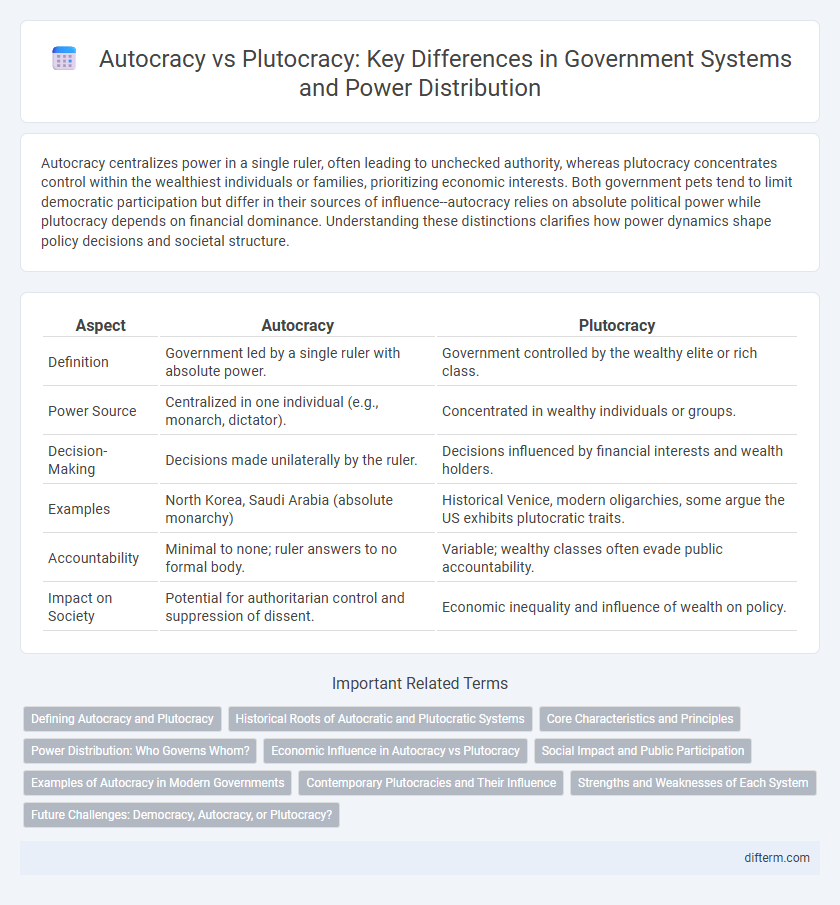Autocracy centralizes power in a single ruler, often leading to unchecked authority, whereas plutocracy concentrates control within the wealthiest individuals or families, prioritizing economic interests. Both government pets tend to limit democratic participation but differ in their sources of influence--autocracy relies on absolute political power while plutocracy depends on financial dominance. Understanding these distinctions clarifies how power dynamics shape policy decisions and societal structure.
Table of Comparison
| Aspect | Autocracy | Plutocracy |
|---|---|---|
| Definition | Government led by a single ruler with absolute power. | Government controlled by the wealthy elite or rich class. |
| Power Source | Centralized in one individual (e.g., monarch, dictator). | Concentrated in wealthy individuals or groups. |
| Decision-Making | Decisions made unilaterally by the ruler. | Decisions influenced by financial interests and wealth holders. |
| Examples | North Korea, Saudi Arabia (absolute monarchy) | Historical Venice, modern oligarchies, some argue the US exhibits plutocratic traits. |
| Accountability | Minimal to none; ruler answers to no formal body. | Variable; wealthy classes often evade public accountability. |
| Impact on Society | Potential for authoritarian control and suppression of dissent. | Economic inequality and influence of wealth on policy. |
Defining Autocracy and Plutocracy
Autocracy is a form of government where absolute power is concentrated in the hands of a single ruler, often a monarch or dictator, who makes decisions without legal constraints or public consent. Plutocracy is a system where political power is controlled by the wealthy elite, enabling influence based on economic status rather than democratic representation. Both systems centralize authority but differ in whether that authority stems from individual rule or financial dominance.
Historical Roots of Autocratic and Plutocratic Systems
Autocratic systems trace their origins to ancient monarchies and empires where absolute power was centralized in a single ruler, exemplified by pharaohs in Egypt and emperors in Rome. Plutocratic governance emerged from the concentration of wealth and influence among elite merchant classes during the Renaissance and early modern periods, notably within Italian city-states like Venice. Both systems historically reflect distinct sources of authority: autocracy from sovereign domination and plutocracy from economic power concentration.
Core Characteristics and Principles
Autocracy centralizes absolute power in the hands of a single ruler, often characterized by unchecked authority, lack of political pluralism, and limited civil liberties. Plutocracy, on the other hand, is defined by governance dominated by the wealthy elite, where economic power translates into political influence, prioritizing policies that protect and enhance elite wealth. Both systems diminish democratic participation but differ fundamentally in the source of their ruling authority--personalistic control versus wealth-driven dominance.
Power Distribution: Who Governs Whom?
In an autocracy, power is concentrated in the hands of a single ruler who governs without checks from other political institutions, often limiting citizen participation in decision-making processes. Plutocracy, by contrast, distributes power among a wealthy elite whose economic influence dictates government policies, prioritizing the interests of the affluent over the general population. The core distinction lies in autocracy's centralized authority versus plutocracy's control rooted in economic power, shaping governance and accountability differently.
Economic Influence in Autocracy vs Plutocracy
Economic influence in autocracy is typically centralized, with the ruling elite or dictator controlling significant resources and directing economic policies to maintain power and suppress opposition. In plutocracy, economic power rests primarily in the hands of wealthy individuals or corporate entities who wield influence through financial means, lobbying, and political donations, shaping policies to favor their economic interests. Both systems limit broad economic participation, but autocracy emphasizes state control while plutocracy prioritizes wealth-driven governance.
Social Impact and Public Participation
Autocracy concentrates power in the hands of a single ruler, severely limiting public participation and often suppressing dissent, which can lead to widespread social inequality and restricted civil liberties. Plutocracy, where wealth dictates political influence, results in policies favoring the wealthy elite while marginalizing lower-income groups, exacerbating social stratification and reducing equitable access to resources. Both systems hinder democratic engagement and produce social environments where the majority's needs are underrepresented in governance decisions.
Examples of Autocracy in Modern Governments
Modern autocracies include countries like North Korea, where power is concentrated in the hands of a single leader, Kim Jong-un, with limited political freedoms and centralized control. Another example is Belarus, under Alexander Lukashenko, often described as Europe's last dictator due to his long-standing authoritative regime. These governments exhibit tight control over media, political opposition, and civil liberties, reinforcing their autocratic rule.
Contemporary Plutocracies and Their Influence
Contemporary plutocracies concentrate power in the hands of wealthy elites, significantly shaping policy decisions and economic priorities to favor corporate interests and capital accumulation. This concentration often undermines democratic principles by limiting broader public participation in governance and perpetuating social inequality. The influence of plutocratic governments manifests in lobbying dominance, regulatory capture, and disproportionate political donations, which collectively erode institutional transparency and accountability.
Strengths and Weaknesses of Each System
Autocracy centralizes power, enabling swift decision-making and policy implementation but often lacks accountability, risking authoritarianism and human rights abuses. Plutocracy channels influence through wealth, potentially driving economic growth and stability while marginalizing broader societal interests and deepening inequality. Both systems concentrate power, yet autocracy emphasizes political control whereas plutocracy prioritizes economic dominance.
Future Challenges: Democracy, Autocracy, or Plutocracy?
Future challenges in governance center on balancing democratic ideals with the rise of autocracy and plutocracy, which threaten equitable political representation and social justice. Increasing economic inequality empowers plutocratic elites, undermining democratic institutions and fostering autocratic tendencies. Effective policy responses must address wealth concentration and safeguard transparent, accountable governance to ensure resilient and inclusive political systems.
Autocracy vs Plutocracy Infographic

 difterm.com
difterm.com